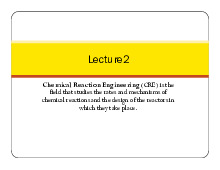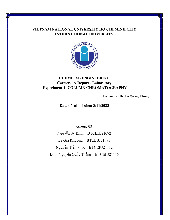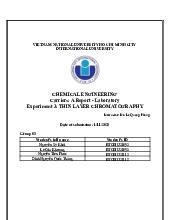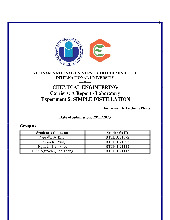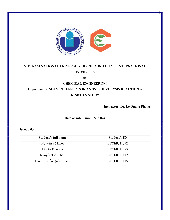







Preview text:
Table of Contents
I. ABSTRACT ........................................................................................................................................... 3
II. INTRODUCTION ............................................................................................................................. 3
III. MATERIALS AND METHODS ...................................................................................................... 4
• Materials ............................................................................................................................................... 4
• Method .................................................................................................................................................. 4
IV. RESULT AND DISCUSSION .......................................................................................................... 5
• Result .................................................................................................................................................... 5
• Discussion ............................................................................................................................................. 6
V. CONCLUSION ................................................................................................................................. 7
VI. LAB NOTES...................................................................................................................................... 8 2 I. ABSTRACT
Liquid-liquid extraction is one of the separation techniques widely used in several sectors.
This procedure differs significantly from distillation as it primarily considers the relative solubility
of the species rather than their volatility. Typically, extraction is a more favorable method than
distillation for separation applications that are not cost-effective and suitable for distillation. This
experiment's purpose was to ascertain the distribution and mass transfer coefficient of Liquidliquid
extraction. This method is used to separate compounds based on their relative solubilities in two
different immiscible liquids, usually aqueous and an organic solvent. In this method after extraction
of sample with tea, solvent mixture containing methyl chloride. Liquid-liquid Extraction is
applicable for tea and by-products. The efficiency and selectivity of the extraction process are
influenced by factors like solvent choice, temperature, pH, and agitation. By optimizing these
parameters, it is possible to get higher yields and greater purity of the extracted chemicals. The
main disadvantage of the Liquid-liquid extraction method is that this method is time-consuming,
tedious, laborious and requires a large number of toxic solvents that pose a potential threat to
human health, environment, problem of emulsion formation, and if there exist lots of target
compounds with significant differences in polarity in samples, it will be difficult to obtain good
separation using a single Liquid-liquid extraction procedure.
The distribution ratio of an analyte is the proportion of its overall concentration in the
organic phase divided by the organic phase in the aqueous phase at equilibrium. The recovery of
the organic compound and enrichment factor increase as the distribution ratio of the analyte
becomes larger and that of the matrix becomes smaller, when extracting the desired organic
compound. Successful enrichment necessitates the reversal of the extraction process while
removing the matrix. Following the extraction process, selectively transferring matrix components
from the organic phase to the aqueous phase through backwashing enhances the enrichment factor. II. INTRODUCTION
Liquid-liquid extraction is a method that divides constituents by their chemical variances
rather than disparities in physical characteristics. The fundamental idea of this procedure involves
the contact between a mixture and an insoluble liquid solvent that is not capable of being mixed
with the original solution but can be mixed with the specific solute present in the original solution
but can be mixed with the specific solute present in the original solution. The transfer occurs due
to the solute’s higher solubility in the solvent present in the feed. The extract is a solution rich in
solvent and contains the desired solute. On the other hand, raffinate is the residual feed solution 3
that contains only a small amount of solute. These two phases are created when the solvent is added,
because of the disparities in densities. The experiment includes methylene chloride, benzene, and petroleum ether. III. MATERIALS AND METHODS • Materials + 1 Erlenmeyer flask 250 mL + 1 Cylinder 10 mL + Heating plate + 1 Cylinder 50 mL + Vacuum filter + Tea + 1 Beaker 100 mL + Methylene chloride
+ 1 Separatory funnel 250 mL with + Benzene stand + Petroleum ether + Balance • Method
First, get the caffeine solution from the tea by filtering off the tea with a baby towel and
funnel (get as much as possible and save the liquids). Secondly, centrifuge the mixture for five
minutes at 5,000 rpm and collect the liquid. After allowing the extract to reach room temperature,
pour it into a 250 mL separatory funnel and use 20 mL portions of methylene chloride to extract
the aqueous solution three times (to prevent the formation of an emulsion, swirl the layers rather
than shake them vigorously). Then, mix the methylene chloride extracts, and use the steam bath to
evaporate the extract until it is completely dry. Don't heat the residue any longer than is required
to cause the solvent to evaporate. Crude caffeine is left over after the solvent evaporates; some
mint smell will be evident. Move to the purification methods, to dissolve the crude caffeine,
transfer it to a clean 50 mL beaker, add 5 mL of benzene, and boil it in a hot water bath. Take the
beaker off of the heat source, pour in 10 mL of petroleum ether (with boiling range from 30 to 60
degrees Celsius), and observe the caffeine crystallize. The product should be collected using
suction filtration, cleaned with 1 mL of petroleum ether, and allowed to air dry and determine the caffeine melting point. 4 IV. RESULT AND DISCUSSION • Result
After extract caffein from tea, the sample was washed with petroleum ether as a wash
solvent because it is relatively nonpolar and can dissolve many nonpolar impurities.
Figure 1: Sample after washing with petroleum ether.
It can be observed that the caffeine recrystallized immediately after adding 10 mL
petroleum ether (30-60). Upon drying sample, the total mass of caffein upon was 0.33g.
Three percent of the mass of green tea is caffeine. Thirty grams of green tea were used in
the experiment to extract caffeine. Consequently, 0.9g of caffeine existed prior to recrystallization.
𝑊𝑒𝑖𝑔ℎ𝑡 𝑜𝑓 𝑐𝑎𝑓𝑓𝑒𝑖𝑛 𝑎𝑓𝑡𝑒𝑟 𝑟𝑒𝑐𝑟𝑦𝑠𝑡𝑎𝑙𝑙𝑖𝑧𝑎𝑡𝑖𝑜𝑛 0.33
%𝑅𝑒𝑐𝑜𝑣𝑒𝑟𝑒𝑑 = × 100% = × 100 % = 36.7%
𝑊𝑒𝑖𝑔ℎ𝑡 𝑜𝑓 𝑐𝑎𝑓𝑓𝑒𝑖𝑛 𝑏𝑒𝑓𝑜𝑟𝑒 𝑟𝑒𝑐𝑟𝑦𝑠𝑡𝑎𝑙𝑙𝑖𝑧𝑎𝑡𝑖𝑜𝑛 0.9 5
Figure 2: Melting point of sample.
In the conclusive stage of the experiment, the determined melting point of caffeine was
recorded as 234.2°C. It is pertinent to note that the accepted melting point range for caffeine is
235-237°C. The observed discrepancy between the experimental and accepted values indicates the
presence of impurities within the sample. This incongruity is suggestive of potential sources of
personal error during the experimental procedures. • Discussion
Caffeine is a polar compound; methylene chloride is either. So, methylene chloride is a
suitable solvent for the extraction of caffeine out of water. Methylene chloride is denser than water,
so it will be the bottom layer when combined with an aqueous solution in a separatory funnel.
When performing liquid-liquid extraction, it is not necessary to drain the methylene chloride and
aqueous solution out of the separatory funnel. After draining methylene chloride out of the
separatory funnel, fresh methylene chloride can be added to the aqueous solution to continue the
extraction of caffeine. Repeat the process three times to maximize the efficiency of the extraction.
Choosing a solvent to dissolve crude caffeine is particularly important in Liquid-liquid
extraction. 1g of caffeine is soluble in 46 mL of water but in 100 mL of benzene at 25oC, so benzene
is more appropriate than water. After dissolving caffeine in benzene, add petroleum ether (30-60)
to the benzene solution to recrystallize caffeine. This phenomenon is the result of its polarity.
Benzene and caffeine are polar compounds, so caffeine can be dissolved in benzene solution, while
petroleum ether is a non-polar compound, so it will reduce the solubility of caffeine in benzene
solution and allow caffeine to recrystallize.
The melting point range of pure caffeine is 235oC-238oC. Due to some technical issues
while performing Liquid-liquid extraction (I.e., shaking the separatory funnel cruelly) the melting
point of caffeine recorded was not in the melting point range (I.e., 234.2oC). This technical issue 6
formed bubbles between 2 layers of aqueous solution and methylene chloride. These bubbles took
some of aqueous solution and went down with methylene chloride. Hence, the crystal contained
some impurities from aqueous solution which leaded to the error in melting point of caffeine.
%Recovery was low (I.e., 36.7%) because methylene chloride was not enough to extract
more caffeine in the aqueous solution. The more repetition of the Liquid-liquid extraction, the more
caffeine would be extracted from the aqueous solution.
This procedure can be scaled up for industrial manufacturing because of its simplicity. The
extraction is safe because there is no reaction in the process. It can be easy to control the whole
extraction process in industry. Do not forget to release pressure drop while mixing aqueous solution
and the organic solvent to ensure the extraction system works safely and smoothly. V. CONCLUSION
To sum up, the Liquid-liquid extraction experiment demonstrated itself to be a useful and
efficient method for separating and purifying chemicals from complicated combinations. The
ability to transfer target chemicals selectively across immiscible liquid phases according to their
varied solubilities demonstrated the effectiveness of this approach. Requirements for effective
extractions included the careful selection of suitable solvents and the rigorous control of
experimental conditions, including temperature and pH.
The experiment also demonstrated how crucial it is to comprehend the chemical
characteristics of solvents and how they interact with other combination constituents. Liquid-liquid
extraction has shown to be versatile with a wide range of applications in areas including
environmental analysis, petrochemicals, and pharmaceuticals. 7 VI. LAB NOTES
Figure 3: Lab notes 13th December. 8
